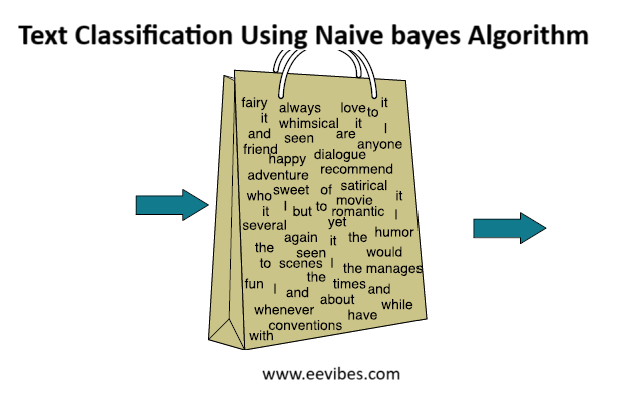
Text Classification
Text classification is a fundamental task in natural language processing (NLP) that involves categorizing text into predefined classes or labels. It is widely used in applications such as spam detection, sentiment analysis, topic labeling, and more. Below is a detailed explanation of text classification, including its key concepts, techniques, and steps.
Text classification using Naive Bayes is a popular and effective approach in machine learning, particularly for handling large datasets. Naive Bayes classifiers are probabilistic machine learning algorithms based on Bayes’ Theorem. They are known for their simplicity and speed, making them useful for real-time predictions and multi-class predictions.
What is Text Classification?
Text classification is the process of assigning a category or label to a given text based on its content. The goal is to automatically analyze and organize text data into meaningful groups.
Examples:
Spam Detection: Classify emails as “spam” or “not spam.”
Sentiment Analysis: Determine if a review is “positive,” “negative,” or “neutral.”
Topic Classification: Assign news articles to categories like “sports,” “politics,” or “technology.”
What is Naive Bayes?
Naive Bayes is a type of probabilistic classifier, meaning it predicts the probability of a given data point belonging to a particular class. It’s based on Bayes’ Theorem, which calculates the posterior probability P(c|x) from prior probabilities P(c), P(x), and likelihood P(x|c).
P(c|x): Posterior probability of class (c) given predictor (x).
P(c): Prior probability of class.
P(x|c): Likelihood, the probability of the predictor given class.
P(x): Prior probability of the predictor.
The “naive” part of Naive Bayes comes from the assumption that all features are independent of each other given the class. In text classification, this means assuming that the presence of a word in a document is independent of the presence of other words, which is often not true in reality. Despite this simplification, Naive Bayes classifiers perform surprisingly well in practice, especially with text data.
How Naive Bayes is Used for Text Classification:
Text documents are converted into a numerical format that the Naive Bayes algorithm can understand. This typically involves techniques like:
Bag of Words (BoW): Counting the frequency of each word in each document.
TF-IDF (Term Frequency-Inverse Document Frequency): Weighting words based on their importance within a document and across the entire corpus.
Training Phase: The classifier is trained on a labeled dataset of text documents. During training, the algorithm calculates:
Prior Probabilities: The probability of each class (e.g., P(Spam), P(Not Spam)).
Likelihood Probabilities: The conditional probability of each word given each class (e.g., P(Word|Spam), P(Word|Not Spam)).
Prediction Phase: To classify a new, unseen text document:
The features are extracted from the new document. The posterior probability is calculated for each class using Bayes’ Theorem and the probabilities learned during training. The document is assigned to the class with the highest posterior probability.
Types of Naive Bayes Models:
Different types of Naive Bayes models accommodate different types of data distributions:
Multinomial Naive Bayes: Frequently used for text classification where features represent word counts or frequencies. It assumes that features are multinomially distributed.
Gaussian Naive Bayes: Assumes that features follow a Gaussian (normal) distribution. While less common in text classification, it can be used when features are continuous.
Bernoulli Naive Bayes: Suitable for binary features (e.g., word presence or absence). It assumes that features are binary-valued.
Advantages of Naive Bayes for Text Classification:
- Naive Bayes classifiers are computationally fast, both in training and prediction, making them suitable for large datasets and real-time applications. The algorithm is relatively easy to understand and implement.
- It performs well with a large number of features, which is common in text data (where each word can be considered a feature).
- Works Well with Categorical Data: Naive Bayes handles categorical input variables effectively.
- Compared to some other complex models, Naive Bayes can perform well even with limited training data when the independence assumption holds.
Disadvantages of Naive Bayes:
The assumption of feature independence is often violated in real-world text data, where words are often dependent on each other. This can affect the accuracy of the classifier.
If a word appears in the test dataset but not in the training dataset, its likelihood probability will be zero, potentially leading to inaccurate predictions. Smoothing techniques (like Laplace smoothing) are used to mitigate this.
When the independence assumption is significantly violated, Naive Bayes may be outperformed by more sophisticated models like Support Vector Machines (SVM) or deep learning models.
Other Applications of Naive Bayes in Text Classification:
- Spam Filtering: Classifying emails as spam or not spam.
- Sentiment Analysis: Determining the sentiment (positive, negative, neutral) expressed in text reviews or social media posts.
- Document Categorization: Automatically categorizing news articles, documents, or product descriptions into predefined categories.
- Topic Detection: Identifying the main topic of a text document.
- Language Detection: Determining the language of a given text.
Text Classification Solved Example
Here is the solved example of text classification where a sentence is classified to be from the class of Tech or Non Tech using Naive Bayes algorithm